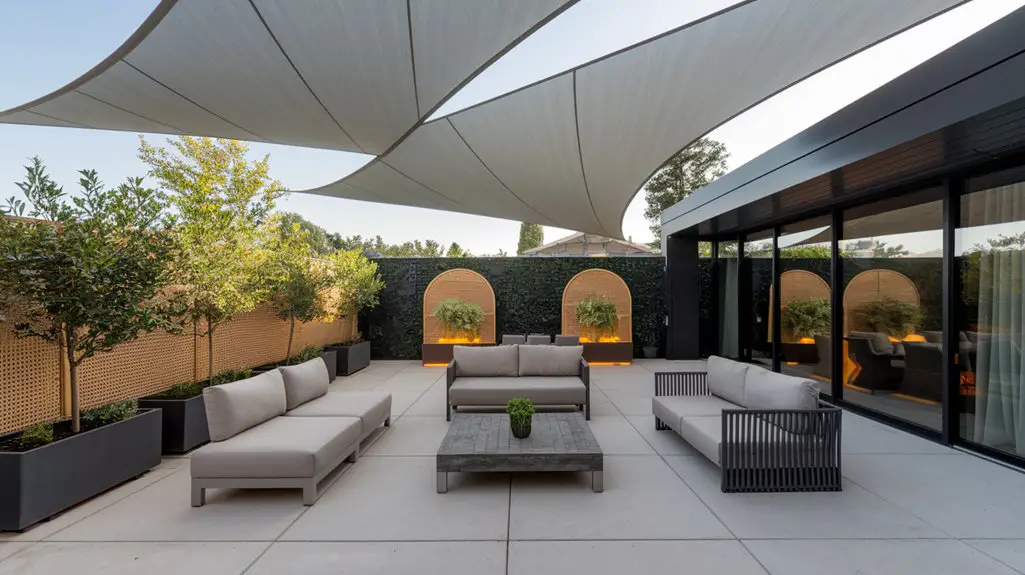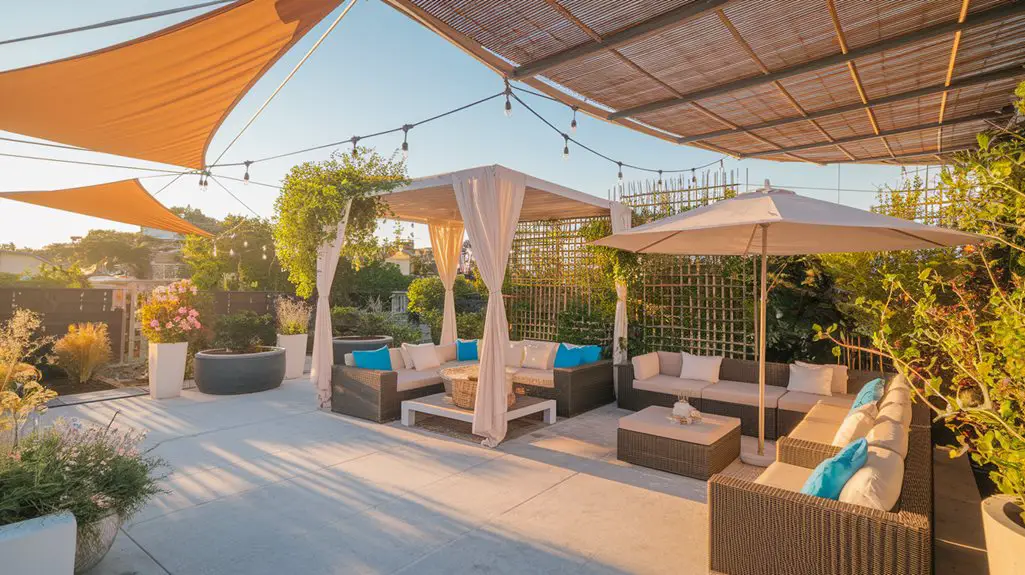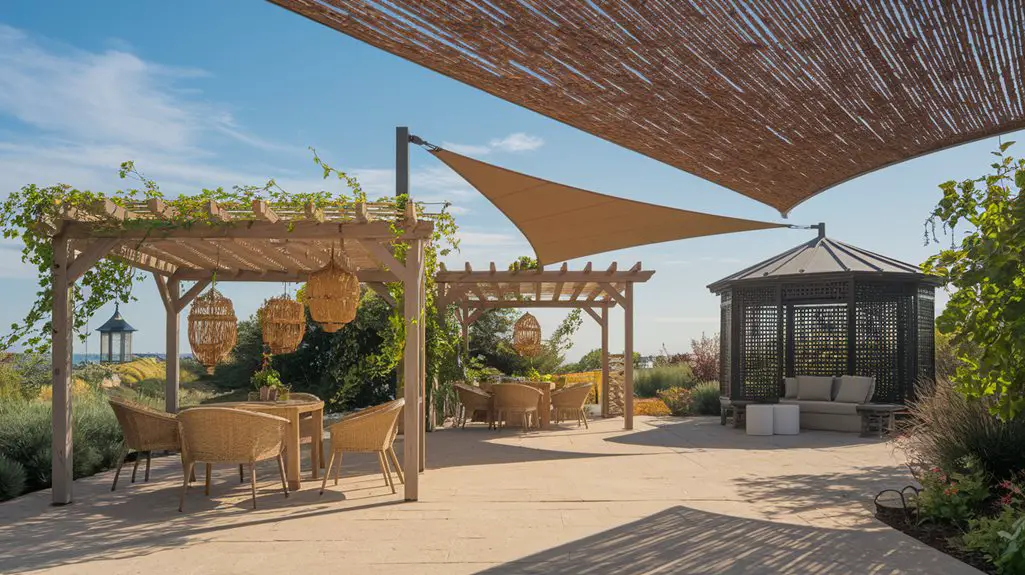Modern outdoor living theory suggests that shade isn’t merely functional—it’s an essential design element that defines your entire patio aesthetic. You’ll notice how thoughtfully designed shade structures transform basic outdoor spaces into sophisticated extensions of your interior style. The interplay of light, shadow, and material creates a dynamic environment that shifts throughout the day. Consider how the right shade solution might not only protect from the elements but also establish your design sensibility across the threshold between home and garden.
Minimalist Pergolas: Sleek Lines for Contemporary Spaces
When reimagining outdoor living spaces, minimalist pergolas offer the perfect architectural statement for contemporary homes. These linear structures create defined outdoor rooms while maintaining visual lightness through their essential framework.
Opt for powder-coated aluminum or steel pergolas in monochromatic finishes—matte black, charcoal, or brushed silver complement modern aesthetics. You’ll achieve maximum impact through clean, horizontal planes that cast rhythmic shadow patterns across your patio.
For truly minimalist appeal, forgo ornate details in favor of precise joinery and thoughtful proportions. Consider retractable canvas panels or integrated louvers to adjust light penetration throughout the day. These features enhance functionality by providing versatile patio shade that adapts to changing weather conditions.
Position your pergola to frame key sightlines or highlight architectural features of your home’s exterior.
The result: a sophisticated overhead plane that defines your outdoor space without overwhelming it—a hallmark of contemporary design thinking.
Statement Retractable Awnings for Design-Forward Patios

Today’s retractable awnings transcend mere functionality to become architectural focal points that elevate outdoor aesthetics. You’ll find bold geometric patterns, metallic finishes, and dramatic color blocking that complement your home’s exterior while making a distinct design statement. Additionally, these awnings provide essential sun protection for your patio, ensuring comfort during sunny days.
When selecting your statement awning, consider how its proportions interact with your patio’s spatial composition.
| Style | Best For | Key Features |
|---|---|---|
| Cantilever | Modern homes | Floating effect, minimal supports |
| Wave-form | Curved architecture | Organic flow, dynamic shadows |
| Cubist | Minimalist spaces | Sharp angles, color blocking |
Motorized systems with weather sensors offer convenience while maintaining design integrity. Opt for marine-grade fabrics in unexpected hues that resist fading. The hardware itself—powder-coated frames in brass, matte black, or brushed steel—should be considered a design element rather than merely structural support.
Floating Canopies and Sail Shades for Architectural Impact

Floating canopies and sail shades transform ordinary patios into architectural masterpieces through their dramatic interplay of tension, negative space, and light diffusion.
These lightweight structures create visual lift while casting dappled shadows that evolve throughout the day.
You’ll find triangular and quadrilateral sails particularly versatile—they can be installed at varying heights and angles to craft geometric compositions above your outdoor space.
Opt for UV-resistant fabrics in overlapping configurations for maximum sun protection and visual interest.
When selecting mounting points, consider leveraging existing structural elements like fascia boards, pergola posts, or adjacent trees.
The negative space between multiple sails becomes as important as the shades themselves, creating rhythm and movement across your patio.
For evening enjoyment, integrate slim LED strips along the tension cables for atmospheric illumination. Additionally, weather-resistant shade options ensure durability and longevity, making them ideal for long-term outdoor use.
Mixed Material Shade Structures: Metal, Wood, and Canvas
The strategic combination of metal, wood, and canvas creates visually dynamic shade structures that balance strength, warmth, and flexibility. When you integrate these complementary materials, you’ll achieve both aesthetic appeal and functional resilience against the elements.
Consider a galvanized steel frame supporting cedar beams, topped with a retractable canvas canopy. This configuration offers structural integrity while allowing for seasonal adjustments.
Alternatively, pair powder-coated aluminum posts with reclaimed wood crossbeams and a stretched sailcloth for a contemporary industrial-organic fusion.
For maximum design impact, contrast materials deliberately—matte black metal against honey-toned wood, or weathered gray timber alongside crisp white canvas.
These juxtapositions create visual tension while maintaining cohesion through thoughtful proportions and connecting hardware that elegantly bridges material shifts. Incorporating top materials for patio shade structures ensures durability and style, enhancing the overall outdoor experience.
Smart Shade Solutions With Integrated Lighting and Technology
Modern outdoor entertainment extends beyond material combinations into the domain of intelligent functionality.
Today’s motorized pergolas and retractable awnings respond to weather conditions via smartphone controls, automatically extending during intense sunlight or retracting during high winds.
Consider installing shade structures with built-in LED strip lighting along beams and posts—providing ambiance while eliminating separate lighting fixtures.
For all-encompassing climate management, select systems with integrated misting components and infrared heaters that extend patio seasons.
Smart mesh fabrics now incorporate photovoltaic elements, harvesting solar energy during daylight hours to power evening lighting.
Look for UV sensors that track sun exposure and communicate with home automation systems, modulating coverage precisely when needed.
These multi-functional solutions transform passive shade elements into responsive environmental controls that enhance your outdoor living experience. Additionally, luxurious shade options can elevate the overall aesthetic of upscale patios.
Lush Living Shade Gardens With Structural Elements
Natural shade gardens strategically integrate vertical structures with cascading vegetation to create three-dimensional cooling zones throughout your outdoor space. You’ll find these living installations offer both aesthetic appeal and functional temperature regulation via evapotranspiration. Incorporating custom shade solutions can further enhance your patio’s comfort and style.
| Structure Type | Plant Pairing | Height Profile | Cooling Effect |
|---|---|---|---|
| Trellised Wall | Wisteria/Ivy | 8-12 ft vertical | High/Diffused |
| Pergola Beams | Grape Vines | 7-9 ft overhead | Moderate/Direct |
| Post Columns | Climbing Roses | 6-10 ft corner | Localized/Intense |
| Cable Systems | Passion Flower | 5-15 ft expandable | Adjustable/Gradient |
Consider positioning these elements to track the sun’s movement, creating dynamic shade patterns throughout the day. The structural components provide immediate shade while your plants mature, eventually yielding a seamless integration of hardscape and living material.
Conclusion
Your shade structure stands as more than protection—it’s the crown of your outdoor sanctuary. As you’ve seen, modern solutions transcend utility, becoming architectural statements that frame your experience. Whether you’re drawn to the minimalist pergola’s clean geometry or the sail shade’s dynamic tension, you’re crafting not just comfort but spatial poetry. Select materials and technologies that speak your design language while orchestrating the perfect interplay of light and shadow.



